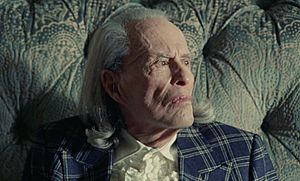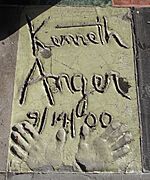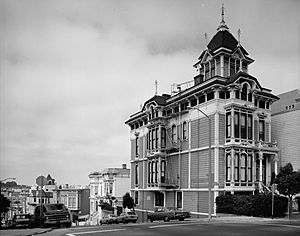Kenneth Anger facts for kids
Quick facts for kids
Kenneth Anger
|
|
|---|---|

Anger in 2019
|
|
| Born |
Kenneth Wilbur Anglemyer
February 3, 1927 Santa Monica, California, U.S.
|
| Died | May 11, 2023 (aged 96) Yucca Valley, California, U.S.
|
| Occupation |
|
| Years active | 1937–2010s |
| Awards | Maya Deren Award (1996) |
Kenneth Anger (born Kenneth Wilbur Anglemyer, February 3, 1927 – May 11, 2023) was an American underground experimental filmmaker, actor, and author. Working exclusively in short films, he produced almost 40 works beginning in 1937, nine of which have been grouped together as the "Magick Lantern Cycle".
Contents
Biography
Early life
Anger was born in Santa Monica, California, as Kenneth Wilbur Anglemyer on February 3, 1927. His father, Wilbur Anglemyer, was of German ancestry, and had been born in Troy, Ohio, while his disabled mother, Lillian Coler (the older of the pair), claimed English ancestry. Anger's parents met at the Ohio State University and after marrying had their first child, Jean Anglemyer, in 1918, followed by a second, Robert "Bob" Anglemyer, in 1921. That year they moved to Santa Monica to be near Lillian's mother, Bertha Coler, who herself had recently moved there. There Wilbur got a job as an electrical engineer at Douglas Aircraft, earning enough money that they could live comfortably as a middle-class family.
Kenneth, their third and final child, was born in 1927, but growing up he did not get along with his parents or siblings. His brother Bob later claimed that as the youngest child, Kenneth had been spoiled by his mother and grandmother, and became somewhat "bratty." His grandmother Bertha was a big influence on the young Kenneth, and supported the family financially during the Great Depression. It was she who first took Kenneth to the cinema, to see a double bill of The Singing Fool and Thunder Over Mexico. She encouraged his artistic interests and later moved into a house in Hollywood with another woman, Miss Diggy, who also encouraged Kenneth. He developed an early interest in film, and enjoyed reading the movie tie-in Big Little books. He later said, "I was a child prodigy who never got smarter." He retrospected his attendance at the Santa Monica Cotillon, where child stars were encouraged to mix with non-famous children and where he met Shirley Temple, with whom he once danced.
In 1935, he later claimed, Anger had the chance to appear in a Hollywood film, taking the role of the Changeling Prince in the 1935 Warner Brothers film A Midsummer Night's Dream. Set photographs and studio production reports (on file in the Warner Brothers collection at University of Southern California, and the Warner Bros. collection of studio key books at George Eastman House in Rochester, New York) contradict Anger's claims, showing that the character was played by a girl named Sheila Brown. Anger's unofficial biographer, Bill Landis, remarked in 1995 that the Changeling Prince was definitely "Anger as a child; visually, he's immediately recognizable".
Career
Anger created his first film in 1937, when he was ten years old. His second work, Who Has Been Rocking My Dreamboat, was made from footage of children playing during the summer, accompanied with popular songs by bands, including the Ink Spots. Anger created Who Has Been Rocking My Dreamboat in 1941, when he was 14, shortly before the Attack on Pearl Harbor and the subsequent entry of the U.S. into World War II. The next year, he produced another amateur film, Prisoner of Mars. In this science fiction-inspired feature, where he played the protagonist, he added elements taken from the Greek mythological myth of the Minotaur and constructed a small volcano in his back yard as a homemade special effect. Many of these early films are considered lost, with Anger burning much of his previous work in 1967.
In 1944, the Anglemyers moved to Hollywood to move in with family, and Kenneth began attending Beverly Hills High School. It was here, he met Maxine Peterson, who had once been the stand-in for Shirley Temple, and he asked her – alongside another classmate and an older woman – to appear in his next film project, which he initially called Demigods, later retitled as Escape Episode.
Around this time, Anger also began attending the screenings of silent films held at Clara Grossman's art gallery, through which he met a fellow filmmaker, Curtis Harrington, with whom he formed Creative Film Associates (CFA). Harrington is said to have introduced Anger to the work of Aleister Crowley. Crowley's philosophy of Thelema would exert a profound influence on the remainder of Anger's career.
At some point in the mid-1940s, Anger decided to move out of his parents' home. He started attending the University of Southern California, where he studied cinema. Around that time Anger struck up a friendship with Dr. Alfred Kinsey that would last until the doctor's death. According to Anger's unofficial biographer Bill Landis, Kinsey became a "father figure" whom Anger "could both interact with and emulate." Meanwhile, in 1949 Anger began work on a film called Puce Women, which was filmed in color. It starred Yvonne Marquis.
In 1950, Anger moved to Paris, France. While in Paris he continued producing short films; in 1950 he started filming on Rabbit's Moon, which was also known as La Lune des Lapins . Anger produced 20 minutes of footage at the Films du Pantheon Studio in the city before he was rushed out of the studio, leaving the film uncompleted. He stored the footage in the disorganized archives of the Cinémathèque Française, and only collected it again in 1970, when he finally finished and released Rabbit's Moon.
In 1953, Anger's mother died and he temporarily returned to the United States in order to assist with the distribution of her estate. It was during this return that he began to once more immerse himself in the artistic scene of California, befriending the film maker Stan Brakhage
Inauguration, which was created in 1954, was a 38-minute surrealist work featuring many Crowleyan and Thelemite themes, with many of the various characters personifying various pagan gods such as Isis, Osiris and Pan. Anger would subsequently exhibit the film at various European film festivals, winning the Prix du Ciné-Club Belge and the Prix de l'Age d'Or.
In 1955, Anger and his friend Alfred Kinsey traveled to the derelict Abbey of Thelema in Cefalù, Sicily, to film a short documentary titled Thelema Abbey. The abbey itself had been used by Aleister Crowley for his commune during the 1920s, and Anger restored many of the wall-paintings that were found there, as well as performing certain Crowleyan rituals at the site. The documentary was made for the British television series Omnibus, but was later lost.
In 1961, Anger began work on a new feature, a film about the biker subculture, which he titled Scorpio Rising. The whole film has a soundtrack made up of popular 1960s songs, including "Blue Velvet" by Bobby Vinton, "Torture" by Kris Jensen and "I Will Follow Him" by Little Peggy March. The film immediately became popular on the underground cinema scene.
Soon after, Anger struck a deal that allowed Hollywood Babylon to be officially published for the first time in the U.S., where it proved a success, selling two million copies during the 1960s.
The mid-1960s saw the emergence of the hippie scene. Anger had become well known throughout the underground scene in the U.S., and several U.S. cinemas screened his better-known films all in one event.
In 1966, Anger moved into the ground floor of a large 19th-century Victorian house in San Francisco known as the Russian Embassy. Around this time he began planning a new film, Lucifer Rising
In 1981, a decade after starting the project, Anger finally finished and released the 30-minute-long Lucifer Rising.
In need of money, Anger subsequently released Hollywood Babylon II in 1984.
In 1986, he sold the video rights to his films, which finally appeared on VHS, allowing them to have greater publicity. The following year he attended the Avignon Film Festival in France where his work was being celebrated in commemoration of the 40th anniversary of Fireworks. Soon after this, he appeared in Kenneth Anger's Hollywood Babylon, a BBC documentary for the Arena series directed by Nigel Finch. In 1991, Anger moved to West Arenas Boulevard in Palm Springs, California, living in what was formerly the estate of his good friend Ruby Keeler.
In 1993, Anger visited Sydney and lectured at a season of his films at the Australian Film Institute Cinema in Paddington.

2000–23: Return to filmmaking and final years
In 2000, Anger began screening a new short film, the anti-smoking Don't Smoke That Cigarette, followed a year later by The Man We Want to Hang, which comprised images of Crowley's paintings that had been shown at a temporary exhibition in Bloomsbury, London. In 2004, he began showing Anger Sees Red, a short surrealistic film starring himself.
Anger's most recent project was Technicolor Skull, with musician Brian Butler, described as a "magick ritual of light and sound in the context of a live performance", in which Anger plays the theremin and Butler plays the guitar and other electronic instruments amid a psychedelic backdrop of colors and skulls.
Anger had finished writing Hollywood Babylon III but did not publish it.
Anger died at a care facility in Yucca Valley, California, on May 11, 2023, at the age of 96. The announcement of his death was delayed until May 24 while his estate was being settled.
Themes
Several recurring themes can be seen within Anger's cinematic work.
One of the central recurring images found in Anger's work is the concept of flames and light.
In many of his films, heavy use is made of music, both classical and pop, to accompany the visual imagery. He first used music to accompany visuals in the 1941 work Who Has Been Rocking My Dreamboat?, where he used tracks by the Mills Brothers. His use of popular music to accompany his films has been cited as a key influence on the development of music videos and of MTV, although he stated his dislike for the whole music video industry.
Awards
- Maya Deren Award, 1996
- Silver Lake Film Festival Spirit of Silver Lake Award (2000)
- San Francisco International Film Festival Golden Gate Persistence of Vision Award (2001)
- Los Angeles Film Critics Association Douglas Edwards Independent/Experimental Film/Video Award (2002), "for his body of work"; tied with Michael Snow, for *Corpus Callosum
- Anthology Film Archives, Life Achievement Award (2010)
See also
 In Spanish: Kenneth Anger para niños
In Spanish: Kenneth Anger para niños


